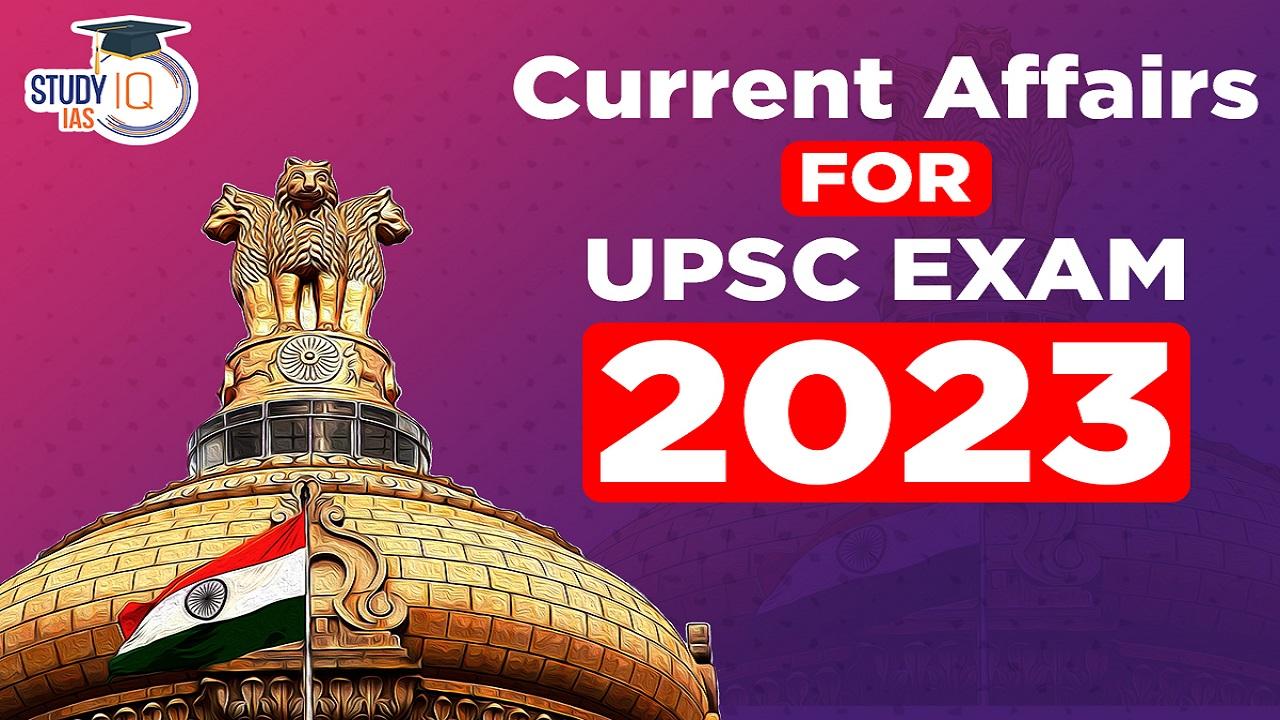Current Affairs 23rd September 2023 for UPSC Prelims Exam
Infrastructure Bonds
Context: The State Bank of India (SBI) achieved a milestone by raising Rs 10,000 crores through infrastructure bonds.
Understanding Infrastructure Bonds
- Infrastructure bonds are bonds issued for the purpose of attracting financing for long-term infrastructure development projects (construction of roads, railways, ports, etc.).
- They are issued with a maturity of at least seven years.
- The proceeds from infrastructure bonds are exempt from reserve requirements like Statutory Liquidity Ratio (SLR) and Cash Reserve Ratio (CRR), according to RBI norms.
- The entire amount of proceedings can be deployed in lending operations.
Related information
Understanding CRR and SLR
| CRR | SLR | |
| What is? | The percentage of total deposits (Net Demand and Time Liabilities or NDTL) that banks are required to hold as cash reserves with the RBI. CRR should be kept on a daily basis. | The percentage of total deposits (demand and time deposits) that banks are required to hold in the form of liquid assets such as government securities. The SLR should not exceed forty per cent. |
| Purpose | To control the money supply in the economy (originally and to facilitate the Lender of Last Resort relationship between banks and the RBI). | To ensure liquidity in the banking system. |
| To be kept with | RBI | Concerned bank itself |
| Regulator/Authority | RBI | RBI |
| Applicability for | All Scheduled Commercial Banks (SCBs) (including Regional Rural Banks), Small Finance Banks (SFBs), Payments Banks, Local Area Banks (LABs), Primary (Urban) Co-operative Banks (UCBs), State Co-operative Banks and District Central Co-operative Banks (DCCBs). | All Scheduled Commercial Banks (SCBs) (including Regional Rural Banks), Small Finance Banks (SFBs), Payments Banks, Local Area Banks (LABs), Primary (Urban) Co-operative Banks (UCBs), State Co-operative Banks and District Central Co-operative Banks (DCCBs)Scheduled Commercial Banks (Including Regional Rural Banks), Small Finance Banks and Payments Banks. |
| Liquidity | Reduces liquidity in the bank but, helps banks to avail the lender of last resort facility as it has deposits with the RBI. | Improves liquidity of banks by providing a buffer against sudden withdrawals and loan defaults. |
| Penalty | Banks are penalized if they fail to maintain the required CRR. | Banks are penalized if they fail to maintain the required SLR. |
| Effectiveness | CRR is a less effective tool to manage the money supply (problem of monetary policy dilemma when inflation and depreciation occurs simultaneously). | SLR is a more effective tool to manage liquidity. |
| Example | If the CRR is 4%, and a bank has total deposits of Rs 100 crores, it must hold Rs 4 crores as cash reserves with the RBI. | If the SLR is 18%, and a bank has total deposits and loans of Rs 100 crores, it must hold Rs 18 crores worth of liquid assets, such as government securities. |
Current Affairs 22nd September 2023 for UPSC Prelims Exam
Personality Rights
Context: The Delhi High Court passed an interim order protecting the personality rights of a Bollywood actor and restrained various entities from misusing his image, name, voice or other elements of his persona for monetary gains without his consent.
What are Personality Rights?
- Personality rights refer to a person’s ability to safeguard his or her identity in the context of a property or privacy right.
- Celebrities value these rights since their names, images, or even voices may be inappropriately used in commercials by various businesses to increase sales.
- Types: Personality rights are divided into two categories:
- The right of publicity: It protects individuals from having their likeness or image used for commercial purposes without their consent or financial compensation. This right is similar to the use of a trademark but not the same.
- The right to privacy: It protects individuals from having their identities disclosed to the public without their consent.
Who is a Celebrity?
- In Titan Industries Ltd. vs. Ramkumar Jewellers, the Delhi High Court in 2012 defined a celebrity as “a famous or a well-known person who “many” people talk about or know about” and further went on to lay down that “The right to control commercial use of human identity is the right to publicity.”
How Personality Rights Are Protected in India?
- There is no separate codified law in India dealing with personality or celebrity rights.
- Article 21: The closest statute to protect personality rights is Article 21 of the Constitution of India under rights to privacy and publicity.
- In Justice K.S. Puttaswamy (Retd.) vs. Union of India 2017, Supreme Court ruled that Right to Privacy is “intrinsic to life and personal liberty” under Article 21.
- Also, the court found publicity to be an element of privacy that is protected as a fundamental right.
- The Copyright Act 1957: As per the provisions of the act, the Authors or the Performers have the right to be given credit or claim authorship of their work and have a negative right restraining other from causing any kind of damage to their work which consequently disrupts their reputation.
- The Indian Trademarks Act, 1999: Section 14 of the act prohibits the use of personal names and representations.
- Passing off and Torts: Personality Rights are also protected under the common law remedy of passing off and that of Law of Torts.
- Passing off: It takes place when someone intentionally or unintentionally passes off their goods or services as those belonging to another party.
- Law of torts: The law of torts in India is a body of law that addresses and provides remedies for non-contractual acts of civil wrongdoings.
Government Securities (G-Secs)
Context: JP Morgan has announced that it will include India in the Government Bond Index-Emerging Markets (GBI-EM) index from June 2024.
About the JP MOrgan’s Bond Index-Emerging Markets (GBI-EM):
- It is a widely recognized index used to track the performance of government bonds issued by emerging market countries.
- It serves as a benchmark for investors and financial institutions interested in monitoring and investing in debt securities from emerging economies.
What are Government Securities?
A Government Security (G-Sec) is a tradeable instrument issued by the Central Government or the State Governments to borrow money. It acknowledges the Government’s debt obligation.
Who issues G-Sec?
The government securities are issued by the Reserve Bank of India (RBI) on behalf of the Government of India in order to finance the fiscal deficit.
- In India, the Central Government issues both, treasury bills and bonds or dated securities while the State Government issue only bonds or dated securities, which are called State Development Loans (SDLs).
Types of G-Secs:
- Short Term: Government securities are short term usually called treasury bills, with original maturities of less than one year.
- Long Term: Usually called Government bonds or dated securities with an original maturity of one year or more).
Advantages of G-Secs:
- Risk-free: Government securities have always been an ideal example of risk-free security. Thus, for investors looking for risk-free investments, government securities are the best option.
- Good long-term returns: These returns are as good as bank deposits; however, unlike bank deposits these deposits are available for a longer duration.
- Good liquidity: Government securities can be bought and sold like equity products. The liquidity in these securities is good as banks and financial institutions regularly participate in this market.
- Portfolio Diversification: A portfolio that includes investments in government bonds is well-diversified for the investor. The risk of the entire portfolio is reduced because government bonds are risk-free investments.
Disadvantages of G-Secs:
- Low Returns: The returns that government bonds are less than that on corporate bonds or equity instruments.
- Especially in the case of long-term bonds, when market interest rates go on increasing, the returns on government bonds eventually turn out to be very low.
- Interest Rate Risk: For government bonds with long-term maturity – 5 – 40 years, there is an interest rate risk. This is because, when the interest rates increase during the tenure of the bond, it becomes more beneficial to invest in newer bonds than the current ones.
- As a result, the bond prices drop to match the yield of the newer bonds.
Potential implications of inclusion of Indian Government Bonds (IGBs) in JP Morgan Index:
The inclusion of IGBs will be staggered over a 10-month period, starting on June 28, 2024, and ending on March 31, 2025, with a one percent increment in its index weight during this period.
- The inclusion is expected to attract higher foreign flows, as many overseas funds are mandated to track global indices.
- It will facilitate large passive investments from overseas, reducing crowding out and making more domestic capital available for industry.
- Experts believe that the benefits of including IGBs in global indices outweigh the risks.
- The JP Morgan index, with India comprising 10 percent of it, will reset the base rate for India, potentially leading to a significant reduction in yield. This will result in a lower cost of borrowing for the Indian government.
Adi Shankaracharya
Context: Madhya Pradesh Chief Minister unveiled the 108 foot tall “Statue of Oneness” of Adi Shankaracharya on the banks of the Narmada river at Omkareshwar recently.
More on News:
- The idol weighs 100 tons and has been installed on a 75-foot-high platform. It is made up of bronze that contains 88% copper, 4% zinc and 8% tin.
- The statue depicts Shankaracharya as a 12-year-old child when he is said to have visited Omkareshwar.
About Adi Shankaracharya:
- Adi Shankara, who is believed to have lived between 788 and 820 AD, was born in Kerela’s Kaladi, situated on the bank of the Periyar River.
- He became a sanyasin at an early age and left his Brahmin household, where he is said to have made his way to Omkareshwar.
- He was a devotee of Shiva.
- He was a disciple Govinda Bhagavatpada and soon became a proponent of Advaita Vedanta, challenging prevailing philosophical traditions – including Buddhism and Jainism.
- Advaita Vedanta:
- It articulates a philosophical position of radical nondualism, a revisionary worldview which it derives from the ancient Upanishadic texts.
- According to Advaita Vedantins, the Upanishads reveal a fundamental principle of nonduality termed ‘brahman’, which is the reality of all things.
- Advaitins understand brahman as transcending individuality and empirical plurality. They seek to establish that the essential core of one’s self (atman) is brahman.
- The fundamental thrust of Advaita Vedanta is that the atman is pure non-intentional consciousness.
- Advaita Vedanta:

- Spiritual Centres associated: Kanchi (Kancheepuram in Tamil Nadu) to Kamrup (Assam), and Kashmir and the Kedar and Badri dhams, as well as Sringeri, Ujjain, Kashi, Puri, and Joshimath.
- The followers of Shankaracharya are called as Smratas.
- He is said to have authored 116 works.
- He wrote commentaries on Brahmasutras. His popular works include- Vivekachudamani, Saundaryalahari, Bhajagovindam, Shivananda Lahari.
- He took Samadhi at the age of 33, at Kedar tirth.
River Periyar:
- Periyar is the longest river in the state of Kerala (also referred to as the lifeline of Kerala).
- Periyar originates in the Sivagiri hills of the Western Ghats and finally joins the Arabian Sea.
- The main tributaries of Periyar are Muthirapuzha, Mullayar, Cheruthoni, Perinjankutti.
- It flows through the Periyar National Park.
QUAD
Context: During the 78th session of the United Nations General Assembly, the Quad Ministers discussed about how to assist countries in dealing with terrorist attacks and reaffirmed their dedication to a “free and open” Indo-Pacific region, where conflicts are resolved following international laws.
What is QUAD?
- The Quad, formally known as the Quadrilateral Security Dialogue, is a strategic forum involving four major democratic countries in the Indo-Pacific region: India, Australia, Japan, and the United States.
- The Quad was initially formed in 2007 during an informal meeting of leaders from the Association of Southeast Asian Nations (ASEAN). It was Japanese Prime Minister Shinzo Abe who first proposed the idea of creating the Quad.
- The Quad is aimed at promoting regional security and economic cooperation in the Indo-Pacific region.
- The four countries share a common interest in maintaining a free and open Indo-Pacific, promoting democracy, human rights, and the rule of law, and countering China’s expanding influence in the region.
- The Quad has held several meetings at the ministerial and leaders’ level to discuss issues such as maritime security, infrastructure development, and supply chain resilience.
- The Quad is seen as a mechanism for balancing China’s influence in the region, although its members have stressed that it is not a military alliance and is open to other countries who share their values and interests.
- Dormancy: After its formalization in 2007, the Quad went dormant for nearly a decade, with concerns, particularly from Australia, that it could strain relations with China.
- Resurrection: The Quad was resurrected in 2017, reflecting a shift in attitudes toward China’s increasing regional influence and assertiveness. It gained renewed momentum as a result of changing geopolitical dynamics.
- U.S. Involvement: The United States views the Quad as a crucial component of its strategies for the Indo-Pacific region and to counterbalance China’s growing influence and assertive actions in the region.
Is QUAD “ASIAN NATO”?
The Quad is often referred to as an informal strategic forum and is sometimes compared to an “Asian NATO” by China and in some media discussions. However, there are significant differences between the Quad and NATO:
- No Mutual Defence Pact: Unlike NATO, which has a formal mutual defense pact where an attack on one member is considered an attack on all, the Quad does not have a mutual defense treaty in place.
- Focus on Economic and Diplomatic Ties: Quad members have emphasized that the group’s main objectives are to deepen economic, diplomatic, and military ties among the four countries. It serves as a platform for discussions and collaboration on various regional and global issues.
- Not Explicitly Anti-China: While the Quad is often seen as a response to China’s regional influence and assertive actions, its members do not explicitly frame it as an anti-China alliance. Instead, they emphasize the promotion of a “free and open Indo-Pacific” and adherence to democratic values.
- Shared Vision for Indo-Pacific: The Quad’s goals include promoting a region that is “free, open, inclusive, healthy, anchored by democratic values, and unconstrained by coercion.” This vision is focused on ensuring the stability and prosperity of the Indo-Pacific region, rather than military confrontation.


 CRPF Foundation Day 2024, Raising Day, A...
CRPF Foundation Day 2024, Raising Day, A...
 Current Affairs 26th July 2024 for UPSC ...
Current Affairs 26th July 2024 for UPSC ...
 APJ Abdul Kalam Death Anniversary 2024, ...
APJ Abdul Kalam Death Anniversary 2024, ...

















